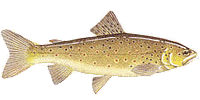Brown Trout Habitat

Good quality brown trout can only be produced in rivers where habitat conditions are suitable. Extensive local and overseas research has identified the types of habitat preferred by trout and which give the best spawning success and survival, as well as fast growth rates, resulting in good numbers of larger fish. The ideal trout stream should have spawning areas of gravel, with water depths 20-100 cm deep and fast flowing water, 30-100 cms per second (cm/sec).
Water temperature during the spawning season (May/June) should be about 2-12°C. Adult brown trout prefer to rest against the bank, protected from overhead view, and in water more than 45 cm deep but with water velocities between 5 and 30 cm/sec. They prefer to move, feed and forage in water more than 45cm deep, although they can pass through barriers and riffles with shallower water. Extensive areas of water over 70 cm deep will facilitate good growth rates resulting in numbers of large-sized fish. Extensive areas of coarse substrate (gravel and rubble) in water 20-100 cm deep, and with water velocities of 30-100 cm/sec, will produce good quantities of macroinvertebrates (e.g. mudeyes, mayfly, stonefly, snails and shrimp) to provide food for fish growth.
The optimum water temperature range for best metabolism of this food and therefore maximum growth is from 7-17°C. Juvenile trout seek cover and protection from larger predatory fish by living in riffles with coarse substrate and water depths of 15-45 cm. The juvenile trout avoid the higher water velocities, which usually occur in the riffles, by sheltering within the coarse substrate.
Any river in Victoria with such conditions will produce good numbers of large brown trout. The most significant limiting factors in the production of large brown trout in Victorian rivers are high water temperatures and a scarcity of water over 70 cm deep. The reason why the Kiewa River produces good numbers and size of brown trout is that their preferred habitat conditions are present in this river. Closed seasons, bag limits or size limits help to share the catch.
